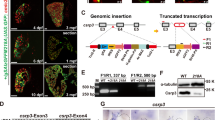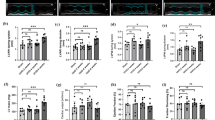Abstract
The development of hypertension-induced cardiac hypertrophy is a complex process involving a number of biochemical pathways. In particular, the translation initiation pathway has been postulated to play an important role in controlling cellular growth and proliferation in the cardiovascular system. Recently, a fundamental translational repressor, NAT1 (novel APOBEC target 1), has been identified. We have previously shown that NAT1 is developmentally-regulated in the heart of neonatal rats and its expression correlates with periods of rapid cardiac growth. The present investigation was designed to determine whether the expression of NAT1 is modified in the left ventricle of spontaneously hypertensive rats and 2-kidney-1-clip (2K1C) hypertensive rats. Northern blot analysis revealed an increase in NAT1 mRNA expression which correlates with the onset of cardiac hypertrophy. Unlike its pattern of mRNA expression, however, NAT1 protein level did not differ significantly from their respective controls throughout the time course. Interestingly, several protein species ranging in size from approximately 40–70 kDa were detected by Western blotting, in addition to the full length 97 kDa NAT1. Since the NAT1 transcript is a known substrate for the enzyme APOBEC-1 and possibly APOBEC-2, we speculate that these proteins may represent truncated fragments of NAT1 resulting from the formation of premature translation termination codons along the NAT1 transcript by APOBEC editing. Together, these results show that the ventricular expression of NAT1 is regulated at the transcriptional level during the early stages of genetic and 2K1C-induced hypertension and may be involved in the onset of left ventricular hypertrophy.
Similar content being viewed by others
References
Imamura T, McDermott PJ, Kent RL, Nagatsu M, Cooper G, Carabello BA: Acute changes in myosin heavy chain synthesis rate in pressure vs. volume overload. Circ Res 75: 418-425, 1994
Mezzetti G, Ferrari S, Davalli P, Battini R, Corti A: Peptide chain initiation and analysis of in vitro translation products in rat heart undergoing hypertrophic growth. J Mol Cell Cardiol 15: 629-635, 1983
Nagai R, Low RB, Stirewalt WS, Alpert NR, Litten RZ: Efficiency and capacity of protein synthesis are increased in pressure overload cardiac hypertrophy. Am J Physiol 255: H325-H328, 1988
Parmacek MS, Magid NM, Lesch M, Decker RS, Samarel AM: Cardiac protein synthesis and degradation during thyroxine-induced left ventricular hypertrophy. Am J Physiol 251: C727-C736, 1986
Everett AW, Sparrow MP, Taylor RR: Early changes in myocardial protein synthesis in vivo in response to right ventricular pressure overload in the dog. J Mol Cell Cardiol 11: 1253-1263, 1979
Mader S, Sonenberg N: Cap binding complexes and cellular growth control. Biochimie 77: 40-44, 1995
Polunovsky VA, Rosenwald IB, Tan AT, White J, Chiang L, Sonenberg N, Bitterman PB: Translational control of programmed cell death: Eukaryotic translation initiation factor 4E blocks apoptosis in growth-factor-restricted fibroblasts with physiologically expressed or deregulated Myc. Mol Cell Biol 16:6573-6581, 1996
Sonenberg N: Regulation of translation and cell growth by eIF-4E. Biochimie 76: 839-846, 1994
Merrick WC: Mechanism and regulation of eukaryotic protein synthesis. Microbiol Rev 56: 291-315, 1992
Imataka H, Olsen HS, Sonenberg N: A new translational regulator with homology to eukaryotic translation initiation factor 4G. EMBO J 16: 817-825, 1997
Rozen F, Edery I, Meerovitch K, Dever TE, Merrick WC, Sonenberg N: Bidirectional RNA helicase activity of eucaryotic translation initiation factors 4A and 4F. Mol Cell Biol 10: 1134-1144, 1990
Lamphear BJ, Kirchweger R, Skern T, Rhoads RE: Mapping of functional domains in eukaryotic protein synthesis initiation factor 4G (eIF4G) with picornaviral proteases. Implications for cap-dependent and cap-independent translational initiation. J Biol Chem 270: 21975-21983, 1995
Pelletier J, Kaplan G, Racaniello VR, Sonenberg N: Cap-independent translation of poliovirus mRNA is conferred by sequence elements within the 5′ noncoding region. Mol Cell Biol 8: 1103-1112, 1988
Yamanaka S, Poksay KS, Arnold KS, Innerarity TL: A novel translational repressor mRNA is edited extensively in livers containing tumors caused by the transgene expression of the apoB mRNA-editing enzyme. Genes Dev 11: 321-333, 1997
Levy-Strumpf N, Deiss LP, Berissi H, Kimchi A: DAP-5, a novel homolog of eukaryotic translation initiation factor 4G isolated as a putative modulator of gamma interferon-induced programmed cell death. Mol Cell Biol 17: 1615-1625, 1997
Imataka H, Sonenberg N: Human eukaryotic translation initiation factor 4G (eIF4G) possesses two separate and independent binding sites for eIF4A. Mol Cell Biol 17: 6940-6947, 1997
Chen SH, Habib G, Yang CY, Gu ZW, Lee BR, Weng SA, Silberman SR, Cai SJ, Deslypere JP, Rosseneu M, Gotto, JM Jr, Li WH, Chan L: Apolipoprotein B-48 is the product of a messenger RNA with an organ-specific in-frame stop codon. Science 238: 363-366, 1987
Liao W, Hong SH, Chan BH, Rudolph FB, Clark SC, Chan L: APOBEC-2, a cardiac-and skeletal muscle-specific member of the cytidine deaminase supergene family. Biochem Biophys Res Commun 260: 398-404, 1999
Pak BJ, Pang SC: Developmental regulation of the translational repressor NAT1 during cardiac development. J Mol Cell Cardiol 31: 1717-1724, 1999
Yamanaka S, Zhang XY, Maeda M, Miura K, Wang S, Farese RV Jr, Iwao H, Innerarity TL: Essential role of NAT1/p97/DAP5 in embryonic differentiation and the retinoic acid pathway. EMBO J 19: 5533-5541, 2000
Wickman A, Friberg P, Adams MA, Matejka GL, Brantsing C, Guron G, Isgaard J: Induction of growth hormone receptor and insulin-like growth factor-I mRNA in aorta and caval vein during hemodynamic challenge. Hypertension 29: 123-130, 1997
Dool JS, Mak AS, Friberg P, Wahlander H, Hawrylechko A, Adams MA: Regional myosin heavy chain expression in volume and pressure overload induced cardiac hypertrophy. Acta Physiol Scand 155: 396-404, 1995
Chomczynski P: A reagent for the single-step simultaneous isolation of RNA, DNA and proteins from cell and tissue samples. Biotechniques 15: 532-537,1993
Sambrooke J, Fritsch EF, Maniatis T: Molecular Cloning: A Laboratory Manual. 2nd edn. Cold Spring Harbor Laboratory Press, New York, 1989
Peterson GL: A simplification of the protein assay method of Lowry et al. which is more generally applicable. Anal Biochem 83: 346-356, 1977
Mamuya W, Chobanian A, Brecher P: Age-related changes in fibronectin expression in spontaneously hypertensive, Wistar-Kyoto, and Wistar rat hearts. Circ Res 71: 1341-1350, 1992
Brilla CG, Maisch B, Weber KT: Renin-angiotensin system and myocardial collagen matrix remodeling in hypertensive heart disease: In vivo and in vitro studies on collagen matrix regulation. Clin Invest 71: S35-S41, 1993
Weber KT, Brilla CG: Pathological hypertrophy and cardiac interstitium. Fibrosis and renin-angiotensin-aldosterone system. Circulation 83: 1849-1865, 1991
Clarke K, Ward LC: Protein synthesis in the early stages of cardiac hypertrophy. Int J Biochem 15: 1267-1271, 1983
Sunga PS, Rabkin SW: Angiotensin II-induced protein phosphorylation in the hypertrophic heart of the Dahl rat. Hypertension 20: 633-642, 1992
Takahashi T, Kawahara Y, Okuda M, Ueno H, Takeshita A, Yokoyama M: Angiotensin II stimulates mitogen-activated protein kinases and protein synthesis by a Ras-independent pathway in vascular smooth muscle cells. J Biol Chem 272: 16018-16022, 1997
Powell LM, Wallis SC, Pease RJ, Edwards YH, Knott TJ, Scott J: A novel form of tissue-specific RNA processing produces apolipoprotein-B48 in intestine. Cell 50: 831-840, 1987
Author information
Authors and Affiliations
Rights and permissions
About this article
Cite this article
Sangaralingham, S.J., Pak, B.J., Tse, M.Y. et al. Expression of the translational repressor NAT1 in experimental models of cardiac hypertrophy. Mol Cell Biochem 245, 183–190 (2003). https://doi.org/10.1023/A:1022884515544
Issue Date:
DOI: https://doi.org/10.1023/A:1022884515544




